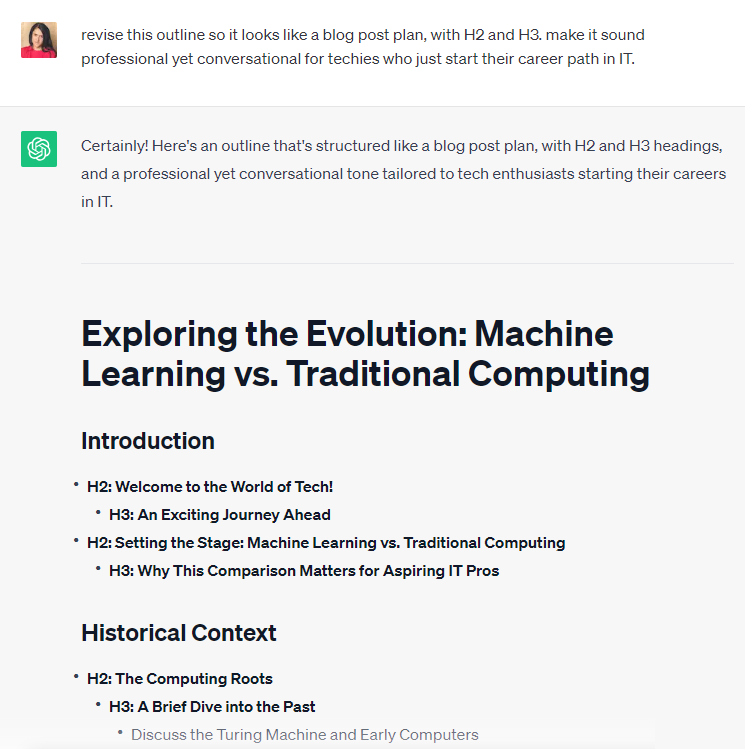How to Prompt ChatGPT So It Writes Quality Tech Texts for Your Website
Don't ask it to write a long text, provide as many details and specs as possible, use proper language, and check via AI detectors.
Join the DZone community and get the full member experience.
Join For FreeRumors have it that techies don't like writing.
Coders, developers, and others with websites understand the role of content but are happy to delegate its creation. No wonder they met the AI text-generating era with a sigh of relief and its emperor ChatGPT — with praise.
They aren't to blame for this.
Despite its numerous bugs, ChatGPT is a helpful hand and a considerable productivity tool for content creators. It saves time on brainstorming, research, and planning; moreover, it finds resources and generates logical and grammatically correct texts in seconds.
Two problems:
- Its texts are generic, with no insights or added value. They look as written by a middle school student who didn't do homework: Wikipedia-like, emotionless, and without the author's experience and thoughts behind them. Online users will hardly enjoy reading such texts as their context and readability leave much to desire.
- ChatGPT's content isn't original. While it successfully cheats plagiarism checkers, it doesn't tell anything new, anything users can't find via online search. LLM systems don't create original texts but analyze the statistical patterns from provided databases to predict likely word sequences and build them into sentences. In other words, they don't know word meanings and can't comprehend their semantics.
That's why AI-generated content doesn't work for audience engagement. More than that, Google will view it as a violation of its spam policies if you are daring enough to use AI strictly to manipulate rankings.

Anything a techie with a website in the pocket can do?
Teach ChatGPT to write high-quality content. Master the art of prompt writing for the tool to craft tech texts that users and search engines will see as unique and worth ranking.
Here's how.
1. Take Some Time to Choose a Topic
The first step is to decide on an exceptional topic for your future text asset. If you have some in your content plan — great! If not, OpenAI's Playground can help. It's more functional, allowing you to experiment with prompting. Here you can:
- Choose different AI models
- Change the length of AI's responses
- Adjust the creativity level of the outputs
Python masters, you can also try configuring the ChatGPT API for it to provide responses tailored to your specifications.
Topics like "Top 10 scripts..." or "How to..." are so overused that ChatGPT will hardly provide you with something original. Try less common templates like alternative solutions or outcomes. Remember to mention your keyword:
A title is the first thing users see to decide if they want to read your content, so it should be informative yet catchy. ChatGPT and other AI tools can't write such titles: All their variants are still generic and alike-looking. What can you do?
1) Specify Your Prompt
Ask ChatGPT to suggest title ideas of different formats. Like this:

2) Polish Its Title
Use some already-winning title formulas.

2. Ask ChatGPT To Write an Outline
Now you have a topic. Before prompting ChatGPT with text, ask it to build a detailed outline.
Not that exciting, I know. Your next step is to revise and improve it: Change OpenAI's Playground presets (temperature, maximum length, etc.) to get another outline or prompt ChatGPT with more specifics.

Better but still boring. Make the outline more "human" and adjust to your content needs: Remove genetic and unnecessary subheads, rename them for better readability, and add subtopics you want to cover for your content to be comprehensive.
- Go to Google and search your keyword to see what others write on the topic. What are their top H2s? Include them in your outline if relevant.
- Or, you can try prompting ChatGPT with sub-tasks to get some content ideas to add to the outline.
3. Optimize the Prompt to the Max
ChatGPT can now write a draft after your outline. For the final text to shine, be super specific. The best ChatGPT prompts include lots of supplementary information.
For technical content, provide detailed context, be explicit, set the format and word count, define the tone and style, and mention the target audience. Use instructive language and experiment with different prompts.
Try this:
[Expand this outline to create an insightful and comprehensive article. The article must contain 1,000 words. Use points of outline as headings and subheadings. Make the article original. Write for techies with 1-2 years in IT, use a conversational tone of voice. Write the article.]
It's critical to include information about headings and subheadings. Also, try prompting ChatGPT with each H2 and H3 separately to prevent repetitions. One of the AI writer's cons is the superficial disclosure of the topic: It has a limited contextual understanding, often sharing the same statements with different words in articles it generates.
It’s actually what savvy developer Mike Mason suggests:
"GPT-3.5 works better with smaller content, such as individual sections of an article. GPT-4 is more adept at handling longer pieces, but it's generally better to use separate conversations with the AI to create an outline and then tackle each major section individually."
Another trick: If you want a final text to mirror a particular writing style of some author, you can try a prompt I call "Write the article as if you're [Name Here]."
The catch: If you want to mirror the writing style of someone less known than Stephen King, ChatGPT may stumble. Instead, provide the tool with text to revise and share the excerpt from the writer's work so it understands the style. I asked it to revise its generated paragraph following Mike Mason's writing style, specifying the prompt first.
I gave ChatGPT a paragraph to revise and a paragraph from Mike's article, asking it to follow the same writing style. Here's what I've got:
4. Check the Draft via AI Detectors and Improve the Quality
Once you have a complete draft from ChatGPT, don't hurry to publish it. AI detectors will likely see it as artificial, and content quality checkers will show it as low-quality and non-unique. If they mark your tech text like this, it's worth revising it again.
To improve the text's uniqueness, go to ChatGPT and type the prompt:
[I'm going to give you some information before asking you to write an article. Do you understand?]
After the tool's positive reply, type this (Feel free to polish the guidelines according to your requirements):
[When it comes to writing content, two factors are crucial, "perplexity" and "burstiness." Perplexity measures the complexity of the text. Burstiness compares the variations of sentences. Humans tend to write with greater burstiness, for example, with more complex sentences alongside shorter ones. AI sentences tend to be more uniform. Therefore, when writing the following content I ask you to create, I need it to have a good amount of perplexity and burstiness. Do you understand?]
Now, type the final query and let ChatGPT revise the text:
[Using the previously written concepts, rewrite the paragraph with high perplexity and burstiness + your text.]
Revise it by sections until it's 100% unique and "human." For even better effect, write your own introduction and conclusion for the text. Those from AI are super generic, killing the reader's motivation to keep investigating what you have for them.
Make the introduction short, add personal examples, and set expectations (preview your content for readers). Also, customize the conclusion and remember to add a relevant call to action (CTA) to generate more leads from your tech text.
Last but not least:
- Add custom images, charts, and other visual content.
- Format the draft for better readability: bullet points, short paragraphs, and examples.
- Link to other relevant pages within the text.
- Add a FAQs section if applicable.
Final Thought
Oh, one more thing:
Please don't write "In conclusion" in your conclusions.
Opinions expressed by DZone contributors are their own.

Comments